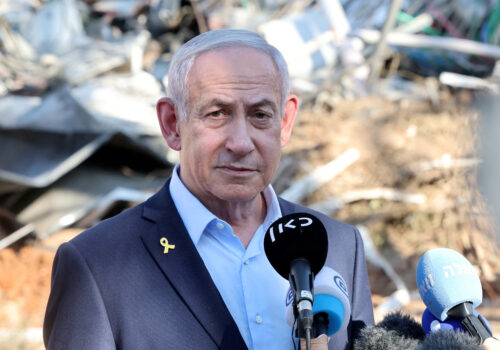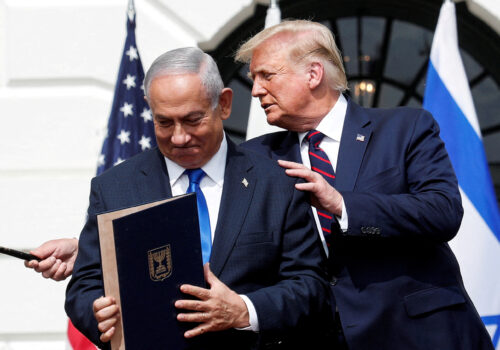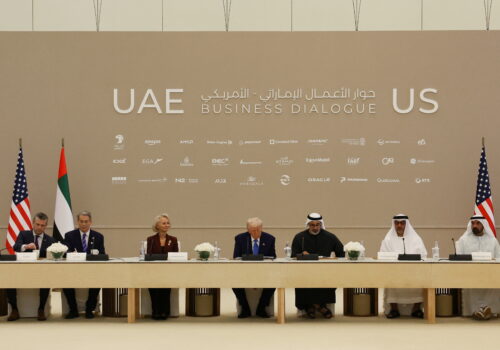Netanyahu’s trip to Washington ends with conflicting signals
It is difficult to know what was achieved this week during Israeli Prime Minister Benjamin Netanyahu’s visit to Washington.
On the matter of Iran, coordination between Israel and the United States appears to be solid. Netanyahu and President Donald Trump seem to agree broadly on Washington’s goals in its talks with Tehran: Iran must relinquish its enriched uranium, agree not to engage in any further uranium enrichment, and permit the safe return and full access of International Atomic Energy Agency inspectors. As the talks proceed, Washington must reinforce the threat of implementing “snapback” sanctions as soon as this fall. And Iran must know that the possibility of additional strikes by Israel or the United States will remain if Iran attempts to reconstitute its nuclear program.
Whether such positions can lead to a deal, as Trump clearly wants, is less certain: Iran is, at this point, unlikely to agree to these terms, as it will not want to appear to capitulate after Israeli and US strikes during last month’s twelve-day war, and will hope to retain a future option to resume its program. So if Washington hopes to achieve these agreements, the Trump administration will need to increase the pressure it exerts against Tehran.
But more uncertain than Trump and Netanyahu’s coordination on hostilities with Iran, is how much progress the leaders achieved in efforts to reach a cease-fire in Gaza and the return of hostages.
In the optimistic scenario, Trump may have made clear to Netanyahu in their second, closed-press meeting at the White House, that he is determined to see the war end, that he wants all the hostages to return home — both the twenty presumed alive and the thirty believed to be deceased—and that he will not accept a resumption of the war after sixty days. (To be clear, no reports have confirmed Trump took this approach, and little has emerged from the second meeting.)
Indeed, numerous reports suggest that US officials have told Qatari negotiators to convey to Hamas that the United States will insist on any cease-fire deal immediately tee-ing up negotiations on a final end to the war, and continuing even past the sixty days until a permanent agreement is reached. Washington’s Special Envoy for the Middle East, Steve Witkoff, may chair these talks himself, according to media reports.
If these reports are correct, it is possible that Trump will not insist that the cease-fire agreement make this commitment to a permanent deal explicit, in order to spare Netanyahu trouble with his hardline coalition partners at home. But that will be the US position all the same.
On the other hand, as these reports circulated during Netanyahu’s four days in Washington, other contradictory signals emerged.
SIGN UP FOR THIS WEEK IN THE MIDEAST NEWSLETTER
Netanyahu pledged to continue fighting until Hamas is completely destroyed, and, more tactically, insisted that the Israel Defense Forces (IDF) will remain in Gaza’s Morag corridor between Khan Younis and Rafah. Hamas opposes the IDF’s presence in this area, beyond the lines of the January-March cease-fire, and new maps are being exchanged to try to narrow the gaps. But Israeli Minister of Defense Yisrael Katz is speaking of herding some 600,000 Palestinian civilians into this small zone abutting the Egyptian border in a so-called “humanitarian city” —an operation the IDF has scarcely begun to plan.
Meanwhile, at the far-right extreme of Netanyahu’s cabinet, Minister of Finance Bezalel Smotrich is making clear that he sees this gathering of Palestinians as a preparation for their departure from Gaza. He says they would leave voluntarily, but just how voluntarily is very much in question—forcing civilians to leave would be considered a violation of international law and a form of ethnic cleansing.
If Israel holds to these positions in the negotiations, there will not be a ceasefire on these more far-right terms. Even if Jerusalem simply floats these terms in public while backing away from them behind closed doors of negotiations in Doha, they could still jeopardize an agreement, and the hostages could remain in the tunnels.
While these talks continue, Trump has his eye on consolidating the regional strategic opportunities presented by the military success against Hamas, Hezbollah, and Iran, and the fall of Bashar al-Assad’s regime in Syria. He wants to reach non-belligerency agreements between Israel, and Lebanon, and Israel and Syria. His Special Envoy to Syria Tom Barrack is actively shuttling in pursuit of them.
Trump also wants to draw Saudi Arabia back into talks on normalization with Israel, as he told Crown Prince Muhammad bin Salman during his visit to the Kingdom in May. He wants to broaden the circle of peace in the region between Washington’s partners—namely, Israel and Arab states. And he wants those Arab states to help send remaining Hamas leaders in Gaza into exile.
But Trump’s patience may have its limits. Netanyahu was at pains to trumpet the alignment between their governments, saying after their meeting that he and Trump are in “full coordination,” and that “everything else that you hear and are being briefed on is folly.” But as long as the war in Gaza continues, the regional breakthroughs Trump is eyeing are unlikely to materialize.
Arab states are likely to wait out the sixty days of a ceasefire—assuming it happens—and see if fighting resumes. They will be reluctant to move forward and present wins to Netanyahu while their public sees scenes on their television screens of the killing Palestinians while trying to reach aid distribution points, or while Israeli ministers talk of evacuating the entire population of Gaza to other lands.
Arab diplomats have consistently told Trump administration officials, as they told former President Joe Biden’s administration before them, that they will not participate in a day-after plan in Gaza that does not include an alternative Palestinian leadership ready to live in peace with Israel that is linked to a reformed Palestinian Authority, as well as concrete steps towards an eventual Palestinian state.
Trump rarely holds back from publicly criticizing foreign leaders who frustrate him. In escaping such public pressure, Netanyahu has the advantage of an irredeemable terrorist organization that has held hostages for nearly 650 days as the opposing party in ceasefire talks. Still, Trump’s silence after his second meeting with Netanyahu was noteworthy. The moment of truth may yet come when Trump’s leverage on Netanyahu, which is considerable, may not be expressed only in private settings.
Daniel B. Shapiro is a Distinguished Fellow in the Scowcroft Middle East Security Initiative. He has served as the US Ambassador to Israel and Deputy Assistant Secretary of Defense for the Middle East.
Further reading
Mon, Jul 7, 2025
Opportunity knocks on Netanyahu’s US visit after Israel-Iran war
MENASource By Shalom Lipner
Prevailing circumstances—albeit fraught with barriers—present the opportunity for all sides to declare victory.
Thu, Jul 3, 2025
Three Abraham Accords goals Trump should raise with Netanyahu
MENASource By Allison Minor
Between Iran and Gaza, Trump and Netanyahu will have a full agenda during the latter’s visit to Washington.
Wed, Jul 9, 2025
For the Gulf, business comes first—even after the Twelve Day War
MENASource By Joze Pelayo
Gulf leaders' desire to shift the regional narrative toward economic and technological development continues to be hijacked by conflict.
Image: U.S. President Donald Trump holds a bilateral dinner with Israeli Prime Minister Benjamin Netanyahu, at the White House in Washington, D.C., U.S., July 7, 2025. REUTERS/Kevin Lamarque



